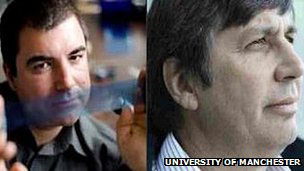| Jan 02, 2012 |
Knighthoods for Nobel-winning graphene pioneers
|
|
(Nanowerk News) Profs Andre Geim and Konstantin Novoselov, from the University of Manchester, won the physics Nobel Prize in 2010 for their pioneering research.
|
|
Dr Venkatraman Ramakrishnan, one of the 2009 chemistry Nobel Prize winners, has also received a knighthood.
|
|
Recipients from technology and science sectors make up 3% of this year's list.
|
|
A knighthood has also been given to Prof Robert Watson, chief scientific adviser to the Department of Environment, Food and Rural Affairs (Defra).
|
|
'Groundbreaking experiments'
|
|
Profs Geim and Novoselov, both originally from Russia, first worked together in the Netherlands before moving to the UK.
|
 |
| Andre Geim (right) and Konstantin Novoselov.
|
|
They were based at the University of Manchester when they published their seminal research paper on graphene in October 2004 (see the paper in Science: "Electric Field Effect in Atomically Thin Carbon Films").
|
|
It was their work on the world's thinnest material that was recognised by the Nobel committee in 2010 for "for groundbreaking experiments regarding the two-dimensional material graphene".
|
|
Graphene is a form of carbon. It is a flat layer of carbon atoms tightly packed into a two-dimensional honeycomb arrangement.
|
|
Because it is so thin, it is also practically transparent. As a conductor of electricity, it performs as well as copper; and as a conductor of heat, it outperforms all other known materials.
|
|
The unusual electronic, mechanical and chemical properties of graphene at the molecular scale promise ultra-fast transistors for electronics.
|
|
Some scientists have predicted that graphene could one day replace silicon - which is the current material of choice for transistors.
|
|
It could also yield incredibly strong, flexible and stable materials and find applications in transparent touch screens or solar cells.
|

